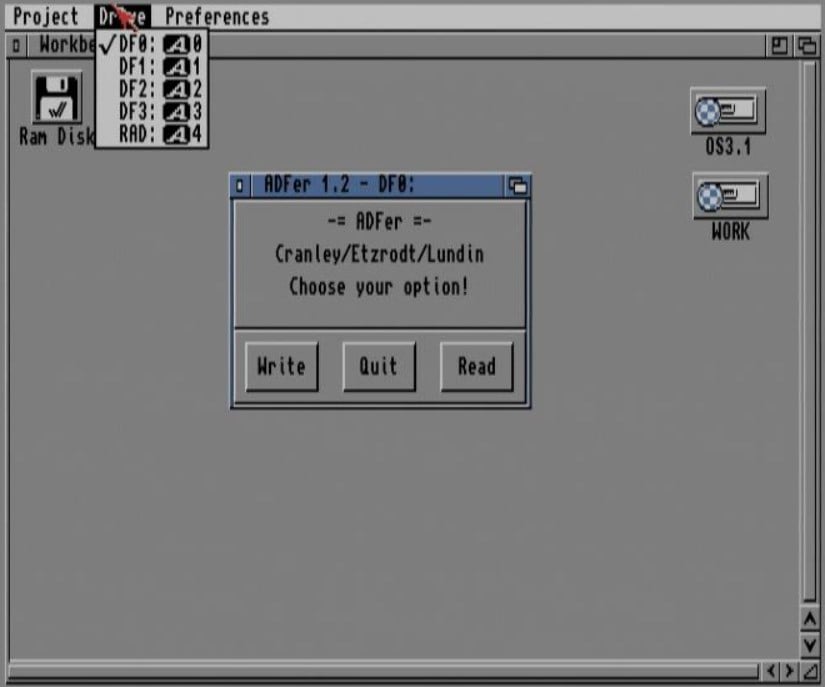| Readme: | Short: Read and Write ADF Files to/from Floppy
Author: Rob Cranley
Uploader: robcranley gmail com (Rob Cranley)
Type: disk/misc
Version: 1.3
Architecture: m68k-amigaos >= 2.0.4
ADFer
~~~~~
ADFer is a tool for reading and writing ADF files.
ADFer is a complete overhaul of the excellent ADF-Blitzer, which has been a
very useful tool for me and many others since it was originally rleased in
1998. However, it hadn't been updated since 2001, and there were a couple of
small improvements I thought it could do with. So I started developing a new
version to include many fixes and new features, while keeping the same
simplicity as the original.
This release is a quick bugfix release that addresses a bug where the verify
and low memory options couldn't be turned off once they were turned on. This
only affected users who weren't using Magic Menu.
New features and fixes since ADF-Blitzer 3 include:
- Rewritten memory routines to eliminate problems with RAM disk use
- Ability to read and write RAD: disks
- Option to verify disks after writing
- Better font sensitivity - uses Workbench screen font
- Automatically selects low memory mode when required
- Removed 68020-specific code so now works on 68000
New features and fixes since ADF-Blitzer 2.2 include:
- Progress bar and cancel button
- Multi-disk writing
- Reworked GUI to fix some minor issues
- Low memory mode (no need to load entire ADF into memory), so works in 0.5MB
- Proper error checking for opening drives, allocating memory etc. so
(hopefully) no more silly crashes
- Fast RAM is no longer required
- Rewritten to use OS calls directly
Usage
~~~~~
ADFer is simple to use. The main window shows 3 buttons: Read, Quit and Write.
Read will read the contents of a floppy in the selected drive and save its
contents as an ADF chosen by you.
Quit simply quits ADFer.
Write will take a chosen ADF and write it to the floppy in the selected drive.
Bear in mind it will do this with no warning if the disk is not write protected!
If multiple ADFs are selected, you will be prompted to insert a floppy for each
ADF before it is written in turn.
The Drive and Settings menus offer some additional options.
Drive lets you select which floppy drive to use, from DF0: to DF3:, or RAD:.
The Preferences menu offers two options: Low Memory Mode and Verify after
writing.
Low Memory Mode can be enabled to use ADFer when there is less than 1MB of free
RAM available. In this mode, only one track is read or written at a time instead
of holding the entire image in RAM at once. This takes much less memory, but can
be slower.
Verify after writing can be enabled to get ADFer to check the newly-written disk
against the ADF file once writing has finished. A message will tell you whether
or not the verification was successful.
Tooltypes
~~~~~~~~~
There are four Tooltypes that can be set in ADFer's icon to control certain
options:
DEFAULTDIR=<path>
Set this tooltype to choose a default directory for ADF files
RADHANDLER=RAD:
This sets the DOS handler used for the RAD: virtual floppy drive
RADDEVICE=ramdrive.device
This sets the device driver used for the RAD: drive
RADUNIT=0
This sets the unit number used for the RAD: drive
Note that the RAD settings should all refer to the same virtual floppy drive.
Thanks
~~~~~~
Thanks to Andreas Etzrodt and Magnus Lundin for their excellent work on
ADF-Blitzer, and for releasing the code on which ADFer is based.
Thanks to everyone who gave feedback and carried out beta testing for me.
Changes in this Version
~~~~~~~~~~~~~~~~~~~~~~~
1.3 (29.08.2019)
Small bugfix release
- Fixed bug where verify and low memory options couldn't be turned off once
enabled. Didn't affect systems that used MagicMenu
Changes since ADF-Blitzer 2.20
~~~~~~~~~~~~~~~~~~~~~~~~~~~~~~
- Complete overhaul of the code, updated to AB3 format
- Added error checking for file and drive accesses
- Added low memory mode, now works on 1MB Amigas
- Reworked GUI to better adapt to different window borders etc.
- Rewrote reading and writing routines
- Added progress bar
- Added Cancel function
- Fixed file requesters (proper size, save mode...)
- Configurable default drawer for ADFs
- Added multi-ADF selection for writing disks
- Changed fast memory requirement to any memory
|

 ADFer_1.3.lha
ADFer_1.3.lha

 Submit files
Submit files